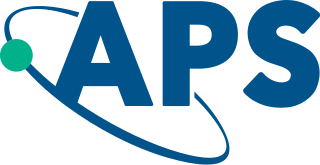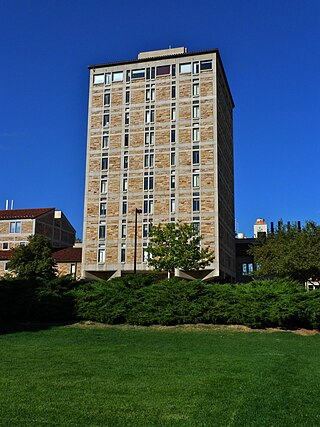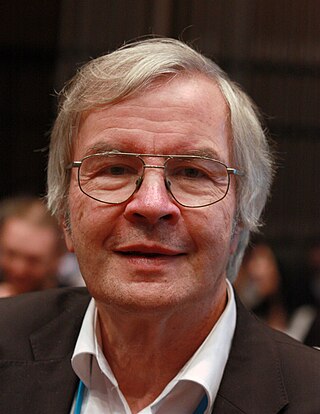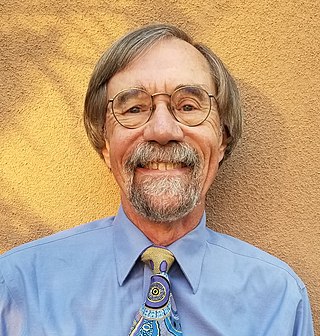Related Research Articles

The speed of light in vacuum, commonly denoted c, is a universal physical constant that is exactly equal to 299,792,458 metres per second. According to the special theory of relativity, c is the upper limit for the speed at which conventional matter or energy can travel through space.

The American Physical Society (APS) is a not-for-profit membership organization of professionals in physics and related disciplines, comprising nearly fifty divisions, sections, and other units. Its mission is the advancement and diffusion of knowledge of physics. The society publishes more than a dozen scientific journals, including the prestigious Physical Review and Physical Review Letters, and organizes more than twenty science meetings each year. APS is a member society of the American Institute of Physics. Since January 2021 the organization has been led by chief executive officer Jonathan Bagger.

JILA, formerly known as the Joint Institute for Laboratory Astrophysics, is a physical science research institute in the United States. JILA is located on the University of Colorado Boulder campus. JILA was founded in 1962 as a joint institute of The University of Colorado Boulder and the National Institute of Standards & Technology.

The Max Planck Institute for Gravitational Physics is a Max Planck Institute whose research is aimed at investigating Einstein's theory of relativity and beyond: Mathematics, quantum gravity, astrophysical relativity, and gravitational-wave astronomy. The institute was founded in 1995 and is located in the Potsdam Science Park in Golm, Potsdam and in Hannover where it closely collaborates with the Leibniz University Hannover. Both the Potsdam and the Hannover parts of the institute are organized in three research departments and host a number of independent research groups.

Theodor Wolfgang Hänsch is a German physicist. He received one-third of the 2005 Nobel Prize in Physics for "contributions to the development of laser-based precision spectroscopy, including the optical frequency comb technique", sharing the prize with John L. Hall and Roy J. Glauber.
Daniel Zissel Freedman is an American theoretical physicist. He is an Emeritus Professor of Physics and Applied Mathematics at the Massachusetts Institute of Technology (MIT), and is currently a visiting professor at Stanford University. He is mainly known for his work in supergravity. He is a member of the U. S. National Academy of Sciences.
James E. Faller was an American physicist and inventor who specialized in the field of gravity. He conceived the Lunar Laser Ranging Program, the goal of which, was to fire high powered laser beams at special retroreflectors placed on the Moon by Apollo program Astronauts. He invented a gravity motion sensor, called the Absolute Gravimeter, which is sensitive enough to detect changes in the local gravitational field due to a person's mass. His work was featured in many books and magazines, such as National Geographic. In 2001, his gravity detection device was featured on the Science Channel in the show Head Rush and was used to debunk anti-gravity devices that were for sale on the market. All devices tested on the show did not produce any kinds of gravitational anomalies. In that same year, he received the Joseph F. Keithley Award for Advances in Measurement Science. His research interests included geophysics, experimental relativity, fundamental constants, and precision measurement experiments designed to look for possible invalidations of accepted physical laws at extreme magnitudes. He worked for the National Institute of Standards and Technology (NIST) and was working on a new measurement of G, the Newtonian constant of gravitation. Faller died on June 14, 2023, at the age of 89.

James A. Isenberg is an American theoretical physicist and mathematician, professor emeritus at the University of Oregon.

Carlton Morris Caves is an American theoretical physicist. He is currently professor emeritus and research professor of physics and astronomy at the University of New Mexico. Caves works in the areas of physics of information; information, entropy, and complexity; quantum information theory; quantum chaos, quantum optics; the theory of non-classical light; the theory of quantum noise; and the quantum theory of measurement. He is a Fellow of the American Physical Society and of the American Association for the Advancement of Science and is a member of the US National Academy of Sciences.

David Jeffery Wineland(born February 24, 1944) is an American Nobel-laureate physicist at the National Institute of Standards and Technology (NIST). His work has included advances in optics, specifically laser-cooling trapped ions and using ions for quantum-computing operations. He was awarded the 2012 Nobel Prize in Physics, jointly with Serge Haroche, for "ground-breaking experimental methods that enable measuring and manipulation of individual quantum systems".

Ana Maria Rey is a Colombian theoretical physicist, professor at University of Colorado at Boulder, a JILA fellow, a fellow at National Institute of Standards and Technology and a fellow of the American Physical Society. Rey was the first Hispanic woman to win the Blavatnik Awards for Young Scientists in 2019. In 2023, she was elected to the National Academy of Sciences. She is currently the chair of DAMOP, the American Physical Society's division in Atomic, Molecular and Optical Physics (AMO).

Jun Ye is a Chinese-American physicist at JILA, National Institute of Standards and Technology, and the University of Colorado Boulder, working primarily in the field of atomic, molecular, and optical physics.

Katharine Blodgett Gebbie was an American astrophysicist and civil servant. She was the founding Director of the Physical Measurement Laboratory of the National Institute of Standards and Technology (NIST), and of its two immediate predecessors, the Physics Laboratory and the Center for Atomic, Molecular and Optical Physics, both for which she was the only Director. During her 22 years of management of these institutions, four of its scientists were awarded the Nobel Prize in Physics. In 2015, the NIST Katharine Blodgett Gebbie Laboratory Building in Boulder, Colorado was named in her honor.
Olga Anatolevna Kocharovskaya is a distinguished professor of physics at Texas A&M University, known for her contributions to laser physics, quantum optics and gamma ray modulation.
Tanya Zelevinsky is a professor of physics at Columbia University. Her research focuses on high-precision spectroscopy of cold molecules for fundamental physics measurements, including molecular lattice clocks, ultracold molecule photodissociation, as well as cooling and quantum state manipulation techniques for diatomic molecules with the goal of testing the Standard Model of particle physics. Zelevinsky graduated from MIT in 1999 and received her Ph.D. from Harvard University in 2004 with Gerald Gabrielse as her thesis advisor. Subsequently, she worked as a post-doctoral research associate at the Joint Institute for Laboratory Astrophysics (JILA) with Jun Ye on atomic lattice clocks. She joined Columbia University as an associate professor of physics in 2008. Professor Zelevinsky became a Fellow of the American Physical Society in 2018 and received the Francis M. Pipkin Award in 2019.
Beverly K. Berger is an American physicist known for her work on gravitational physics, especially gravitational waves, gravitons, and gravitational singularities. Alongside Berger's more serious physics research, she is also known for noticing that vibrational patterns caused by local ravens were interfering with observations at the Laser Interferometer Gravitational-Wave Observatory.
Stanley Ernest Whitcomb is an American physicist and was the chief scientist at the Laser Interferometer Gravitational-Wave Observatory (LIGO) project when the first direct detection of gravitational waves was made in September 2015.
The Francis M. Pipkin Award is a physics prize given by the American Physical Society (APS) every two years since 1999.

Randy Alan Bartels is an American investigator at the Morgridge Institute for Research and a professor of Biomedical Engineering at the University of Wisconsin–Madison. He has been awarded the Adolph Lomb Medal from the Optical Society of America, a National Science Foundation CAREER award, a Sloan Research Fellowship in physics, an Office of Naval Research Young Investigator Award, a Beckman Young Investigator Award, and a Presidential Early Career Award for Science and Engineering (PECASE). In 2020 and 2022, he received support from the Chan Zuckerberg Initiative to develop microscope technologies for imaging tissues and cells.
References
- ↑ Bergquist, Jim (March 2006), "To the laser maestro", Proceedings of the John Hall Symposium, World Scientific, pp. 108–109, doi:10.1142/9789812773845_0020, ISBN 978-981-256-745-1,
I had moved up one floor and from the invisible infrared spectral region into the visible. I decided immediately that this was a superior place to play, but it was also the territorial domain of Siu Au Lee
- 1 2 "A history of discovery: 2000" (PDF), Elements, Colorado State University College of Natural Sciences, p. 11, retrieved 2021-09-22
- ↑ "W.M. Keck Foundation gives Colorado State University $1.1m for quantum computer research", Nanowerk, 31 January 2008, retrieved 2021-09-22
- 1 2 "Siu Au Lee", Faculty & Staff, Colorado State University Department of Physics, retrieved 2021-09-22
- ↑ CSU Physics Prof. Siu Au Lee serving as NSF program manager, Colorado State University Department of Physics, retrieved 2021-09-22
- ↑ "Fellows nominated in 1998 by the Topical Group on Precision Measurement & Fundamental Constants", APS Fellows archive, retrieved 2021-09-22
- ↑ Elected fellows, Optical Society of America, retrieved 2021-09-22
- ↑ History of Distinguished Alumni Awards, University of Wisconsin–Madison Department of Physics, retrieved 2021-09-22